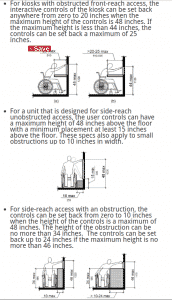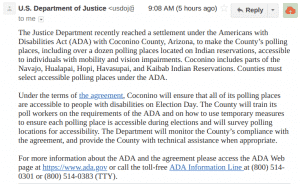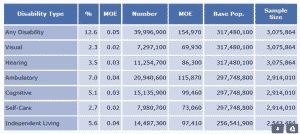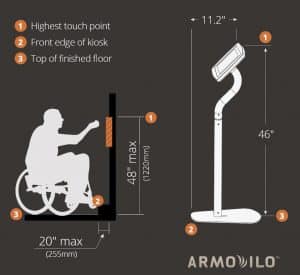Table of Contents
Kiosk ADA Accessibility ADA Compliance
October/November – waiting on EV regulations to be issued. New guidance for self-service kiosks and POS is in progress and due out before end of 2023.
July 2023 — New NPRM on web accessibility and mobile by DOJ.
June 15, 2023 — New updated dates for US Access Board NPRMs for EV and POS. Also, ANSI has just released their new EV standards, which include ADA considerations. Thanks to Steve Taylor with TaylorPOS for reminding us of the NPRM dates.
Useful reference links:
- SELF-SERVICE Dec 2023 https://www.reginfo.gov/public/do/eAgendaViewRule?pubId=202304&RIN=3014-AA44
- EV NPRM 9/00/23 https://www.reginfo.gov/public/do/eAgendaViewRule?pubId=202304&RIN=3014-AA48
- Note there are two different listings for the EV item. The links provided for the NPRM on electric vehicle charging stations are from two different unified agendas – the Fall 2022 and the Spring 2023 agenda. Please refer to the September 2023 date in the Spring 2023 agenda, as this represents the most recent projected date for publication.
- ANSI regs now issued — Roadmap of Standards and Codes for Electric Vehicles at Scale
- Here is our running Legal chronology log for self-service
Interesting that the FCC is looking at Conferencing platforms and accessibility. Video conferencing platforms like Zoom, Microsoft Teams, and Webex could be subject to accessibility requirements under a proposal from FCC Chairwoman Jessica Rosenworcel. Link on AVIXA
Accessibility Guidelines for Self-Service Transaction Machines
This rulemaking would amend the Architectural and Transportation Compliance Board’s existing accessibility guidelines for buildings and facilities under the Americans with Disabilities Act (ADA) and the Architectural Barriers Act (ABA), located at 36 CFR part 1191, to include guidelines for the accessibility of fixed self-service transaction machines, self-service kiosks, information transaction machines, and point-of-sale devices. The U.S. Department of Transportation and U.S. Department of Justice are expected, via separate rulemakings, to adopt these amended guidelines as enforceable standards for devices and equipment covered by the ADA. RIN: 3014-AA44
Tools We Use Everyday
- Google PageSpeed Insights — tests speed and accessibility
- MS Edge Accessibility Insights — quick fast pass for accessibility (WCAG 2.1)
- Experte — free web tools based in Germany, also WCAG 2.1 — will test entire website for you
Latest News and Posts
- ADA Kiosk News – DOJ Title II final rule
- European Accessibility EAA Guidelines & Storm Interface
- ADA Regulations Coming – ADA Accessibility Guidelines
- ADA Accessibility Update – U.S. Access Board Timelines
- Assistive Technology
- JAWS Kiosk Screenreader Comes to Penn State Food Service
- Kiosk Accessibility Event – M-Enabling Summit
- ADA Kiosks – HHS Section 504 Proposed Rule Writeup
- EV Charging Stations – Designing in Accessibility
- ADA Kiosk – WCAG Closed Systems Guidance- Comment Period
- DOJ NPRM on Web and Mobile Accessibility
- Disabled and Impaired Population Numbers – ADA
- PSA – ADA Regulations for EV Vehicles, – Assistive Tech
- HIMSS 2023 Self Service and Accessibility on Display in Booth 7431
- Kiosks and people who are blind or partially sighted
- EV Accessibility Regulations in UK (and Europe too?)
- Self Service Kiosk News Feb 2023
- ADA Retail Restaurants Regulations – 2023
- PSA – ADA Webinar for Retail & Restaurants
- Grocery Self-Checkout & Disabled Shoppers – Food Institute
August 2022 Update –
- Announcements of the coming ANPRM announcement are showing up. (example)
- From Justice.gov – Kiosks and Other Information Transaction Machines — this was the first try by government to create “ITM” designation. At the top of the list was ATMs. Back then “few agencies used ITMs” — Overall its an old iteration and even has some obsolete links to Trace (which sold all of its IP to a private company). Worth noting Trace was funded by tax dollars and the public thru a grant.
Regulatory agencies have a profound effect on the business of self-service. The kiosk manufacturer association (KMA) monitors kiosk and self-service ADA, Accessibility and the development & implementation of regulatory bodies and, where possible, we participate in the regulatory process by educating and informing agencies regarding our members & businesses.
The Kiosk Manufacturer Association has looked at the various ADA regulations in the marketplace and distilled the “kiosk applicable” regulations. There are actually two sets the KMA provides. The first are the current Mandatory requirements as reviewed by KMA with the U.S. Access Board. The second is code of practice going forward with includes newer technologies such as voice command.
The fast reference for kiosks is our ADA Kiosk Checklist. Twenty questions you should ask yourself when planning a kiosk deployment. Ad hoc questions regarding ADA are also covered in our Kiosks ADA FAQ.
For EV charging infrastructure the latest Design Guidelines by the U.S. Access Board are a must read. We expect ANPRM in August and then the comments period before codification later this year. And not only EV infrastructure but also Kiosks and POS.
Send an email to [email protected] or call at 720-324-1837 for more details. The KMA provides this information in complete form to any and all companies looking to deploy a self-service kiosk project as well as governmental entities. A small administration fee of $250 is the only cost. Contact [email protected] or call at 720-324-1837
Recommended ADA Resources
- Vispero – The Paciello Group (part of Vispero): The Paciello Group (TPG) is a world-class accessibility consultancy with a reputation for excellence. TPG helps clients achieve end-to-end accessibility for both software and hardware, including accessibility reviews and VPATs.
- A primary source of ADA devices for accessibility is Storm Interface. They also make rugged keyboards and other input devices. Storm also produced a very informative paper on Pin Pad Accessibility. — Accessibility – Implications on Keypad Design by Steve Greenaway
- Tech For All Consulting – Making Technology Accessible for Everyone. Experts in evaluation and universal design. Specialists in ADA and Accessibility.
- YourDolphin Supernova kiosk software —
- MimoMonitors – along with all types of touchscreens, Mimo also offers a haptic touchscreen for accessibility
ADA and Disability in the News
- Legal Action Kiosks
- ADA Kiosk – High Level Overview of Rule Making U.S. Access Board(Opens in a new browser tab)
- ADA Kiosk News from the U.S. Access Board – March/ April 2019(Opens in a new browser tab)
- Section 508(Opens in a new browser tab)
- ADA Kiosk – revised Section 508 Standards affecting hardware (audio)(Opens in a new browser tab)
- EV Charging ADA Considerations – a Kiosk Perspective
- McDonald’s Kiosk News – Delivering More Accessible With Storm
- Latest legal decisions impacting self-service
- Questions about ADA? – see the plain English FAQ on kma.global
- New Accessibility technology gives disabled LIRR riders an assist boarding trains
- Greyhound 3.2M Settlement
- Accessibility 30 years later
- How To Prevent ADA Website Lawsuits
- Accessibility at the Forefront of Tech
[do_widget id=rss-8]
ADA Tools
- What About Mobile Apps? Here is a summation of Section 508 by the Veterans Administration. Section 508 Mobile Best PracticesSummary
- Color Contrast Analyser (CCA) Helps you determine the color legibility of text, and images of text.
- Web Accessibility Toolbar (WAT)Helps you evaluate a web page for accessibility and standards conformance. (This tool is no longer in active development)
- Accessibility Viewer (aViewer)Lets you inspect web content for accessibility information based on MSAA, iAccessible2, UIAutomation and ARIA.
- ARC ToolkitA professional level single-page accessibility testing tool available on the Google Chrome store.
- Tenon.io – Tenon.io can identify 508 and WCAG 2.0 issues in any environment.
- Aira.io – augmented reality assistance for the Blind
- SmyleMouse – computer navigation by head gesture and blinking eyes
- WP Accessibility plugin — we utilize this for improving our web accessibility
- Google Tools — many tools for websites and handhelds and mobiles. Test suites.
ADA Reference Resources
- Revised 508 the Final Rule – 2018
- ICT Standards – 2017
- ADA 2010
- More background information
- ANSI Process
- ANSI-Essential-Requirements-2018
- FINAL DRAFT Whitepaper. The Use of Voice Recognition and Speech Command Technology as an Assistive Interface for ICT in Public Spaces
- Associations
- National Association of Deaf
- Federation of Blind
- American Foundation of Blind
- UK — Royal Institute of Blind (RNIB)
- Worth noting BSI standards in UK and ETSI in Europe
VPAT Resources
We see in the SLED market sometimes the requirement for VPAT. VPAT Compatibility allows for self-certification. VPAT has variations focused on Section 508, the European standard EN 301-549, WCAG 2.1 and one that includes all. You can download the templates below and review. These are recommended by Section 508 for all Federal to be generated when ICT is involved.
- VPAT 2.4 508: Revised Section 508 standards – the U.S. Federal accessibility standard
- VPAT 2.4 EU: EN 301 549 – the European Union’s “Accessibility requirements suitable for public procurement of ICT products and services in Europe”
- VPAT 2.4 WCAG: WCAG 2.1 or ISO/IEC 40500 – W3C/WAI’s recently updated Web Content Accessibility Guidelines
- VPAT 2.4 INT: Incorporate all three of the above standards
- VPAT Resources on Section 508 website
Please note that WCAG 2.1 is incorporated into the EU, WCAG, and INT editions of the VPAT.
All four editions of the VPAT contain:
- Instructions covering essential requirements to use the VPAT service mark and best practices, which provide for consistent, uniform and more complete reporting by manufacturers.
- A Product Description field that briefly describes the product.
- An Evaluation Methods Used field to describe methods used to test the product’s accessibility.
- A Notes field for the report and for each table to provide additional detail concerning the product tested and the evaluation methods.
- Provided as a Microsoft Word file that can be used as is or reproduced in other formats.
PLEASE NOTE: While a VPAT can be an essential aid in assessing the availability of ICT products with accessibility features, it is important to note that, even in cases where a product conforms to relevant standards and technical specifications, an end user may still encounter difficulties utilizing it due to the nature or severity of his or her disability. On the other hand, a product that may not fully conform to all technical requirements may still be perfectly accessible to an end user who has a disability, but does not need a particular accessibility feature, e.g., a large-button telephone handset for an individual with a hearing disability.
While there may not be a perfectly accessible product, many can still be used effectively and efficiently by most people with disabilities. ITI has developed a paper offering recommendations on how ICT purchasers can utilize VPAT-generated Accessibility Conformance Reports to sort through such matters. Please see the document entitled “Reporting Conformance to ICT Accessibility Standards.”
Accessibility Companies
- Tenon.io – Tenon.io can identify 508 and WCAG 2.0 issues in any environment.
- Aira.io – augmented reality assistance for the Blind
- Right Hear — micro-positioning wayfinding mobile apps for the blind
- SmyleMouse – computer navigation by head gesture and blinking eyes
- WP Accessibility plugin — we utilize this for improving our web accessibility
- Google Tools — many tools for websites and handhelds and mobiles. Test suites.
- Kessler McGuiness ADA
- Webaim – web accessibility
- Overview of ADA by CUInsight
- TENON for testing accessibility on your website
- I-Communicator Resources – link
- Spacepole
Here are resources which can assist.
- Information Technology Industry Council – trade association
- International Association of Accessibility Professionals
- Wheeled Mobility Project — The entire report can be downloaded from that page. Please pay particular attention to Section 3.3.15 Reach. Also, the following sections are related to reach and, to some extent, explain the data: 3.3.6 Knee Clearance Height, minimum; 3.3.7 Toe Clearance Height, minimum; 3.3.8 Knee Clearance Depth, minimum; and 3.3.9 Toe Clearance Depth, minimum. Section 3.3.14 Grip Strength may also be of interest.
- Living With Spinal Cord Injury
- SCI-Driving-508 Factsheet
- AIM High Act
ADA Kiosk Links
- ADA.Gov lists all the resources in one place in the Accessible Technology section of the website.
- ADA Parking Guidelines (shows ratio)
- Revised 508 Standards – went into effect January 18, 2018
- ict-rule-2018 effective 2018
- EN 301 549 V1.1.2 European Standards — Accessibility requirements suitable for public procurement of ICT products and services in Europe
- Software — iCommunicator software is NLP that converts speech to text and also speech to sign language.
- 10/01/2018 – New ADA.Gov Technical Assistance
- 10/01/2018 – ADA FAQ on KMA
Pin Pad Regulatory Guidelines
- EN 1332 Machine readable cards, related device interfaces and operations. Part 3 Keypads.
- V EN 29241 Part 4 Keyboard requirements.
- ETSI DTR/HF 02009 (1996) Characteristics of telephone keypads.
- ETSI TCR–TR 023 (1994) Assignment of alphabetic letters to digits on push button dialling keypads.
- ETSI ES 201 381 (December 1998) Telecommunication keypads and keyboards: Tactile identifiers.
- IEC 73 Colours of pushbuttons and their meanings.
- ISO/IEC 9995 Information technology: Keyboard layouts for text and office systems.
- ITU E161 Arrangements of figures, letters and symbols on telephones.
- Storm – informative historical paper on Pin Pad Accessibility. Note this is from 2003 and changes since then. Accessibility – Implications on Keypad Design by Steve Greenaway
- Full specs for EPPs — Regulations EPP Pin Pads- 2020
Interesting News
- Raising the Floor
- Accessibility Recap NYC LinkNYC
- A New Spin on Song-Beverly Act Litigation Against Retailers – how personal PII enters the equation. Also cameras and the proximity of the POS device.
- DOJ and Arizona settle on providing accessibility during voting
Measuring the Disabled – 2022
2015-StatusReport_US
DEAF — Across the globe, it is estimated that there are more than 70 million deaf people that use some variation of a sign language as their primary form of communication. Of these people, it is estimated that 80% or more reside in developing countries. Across the globe, in excess of 300 different sign languages are in operation.
Guidelines and Standards
Communications & IT
Access to information and communication technology (ICT) is addressed by Board standards and guidelines issued under Section 508 of the Rehabilitation Act and Section 255 of the Communications Act. The Board jointly updated its Section 508 Standards and Section 255 Guidelines in January 2017.
Buildings & Sites
Standards issued under the Americans with Disabilities Act (ADA) address access in new construction and alterations to state and local government facilities, places of public accommodation, and commercial facilities. Similar standards apply under the Architectural Barriers Act (ABA) to facilities funded by the federal government. The Board issued supplementary guidelines for emergency transportable housing in 2014 that are not yet part of the ADA or ABA Standards.
Recreation Facilities
Access to recreation facilities, including play areas, swimming pools, sports facilities, fishing piers, boating facilities, golf courses, and amusement rides is addressed in the ADA and ABA standards. The ABA Standards also include provisions for trails, picnic and camping areas, viewing areas, and beach access routes on federal lands.
- Recreation Facilities (ADA and ABA Standards)
- Outdoor Developed Areas (ABA Standards)
Streets and Sidewalks
New guidelines the Board is developing will cover access to public rights-of-way, including sidewalks, intersections, street crossings, and on-street parking. The Board is also addressing access to shared use paths providing off-road means of transportation and recreation.
Transportation
Board guidelines issued under the ADA address access to public transportation facilities and vehicles. New guidelines for passenger vessels are in development.
Health Care
The Board has issued standards for medical diagnostic equipment and guidance on prescription drug container labels.
- Medical Diagnostic Equipment Accessibility Standards
- Prescription Drug Container Labels (advisory guidance)
ADA News
- Disabled and Impaired Population Numbers – ADA August 7, 2023
- Participate in Retail Advisory Council for ADA & Accessibility for Self-Service and Kiosks December 16, 2018
- U.S. Access Board 2018 Meeting KMA ADA Board November 11, 2018
- Health device companies adapt to Apple nixing headphone jack September 11, 2016
- ADA Wheelchair Animations – United States Access Board September 2, 2014
Americans with Disabilities Act
The Americans with Disabilities Act of 1990 (ADA) prohibits discrimination and ensures equal opportunity and access for persons with disabilities.
The Federal Transit Administration works to ensure nondiscriminatory transportation in support of our mission to enhance the social and economic quality of life for all Americans. The FTA Office of Civil Rights is responsible for civil rights compliance and monitoring to ensure nondiscriminatory provision of public transit services.
ADA Circular
- Americans with Disabilities Act: Guidance (PDF)
- Americans with Disabilities Act: Guidance (Word version)
- ADA Circular press release
- FTA Acting Administrator Therese McMillan statement[external link]
- FTA ADA Circular Fact Sheet (PDF)
- ADA Circular training series
DOT Legal Opinion on Facility Alterations
ADA Dear Colleague Letters
ADA Final Rule on Reasonable Modification
ADA Regulations
- Part 27–Nondiscrimination on the Basis of Disability in Programs or Activities Receiving Federal Financial Assistance
- Part 37–Transportation Services for Individuals with Disabilities
- Part 38–Accessibility Specifications for Transportation Vehicles
- Part 39–Transportation for Individuals with Disabilities: Passenger Vessels
Tips for ADA Compliance
The Department of Justice has launched a new Accessible Technology section for ADA.gov, its Americans with Disabilities Act (ADA) Web site, to further assist covered entities and people with disabilities to understand how the ADA applies to certain technologies, such as Web sites, electronic book readers, online courses, and point-of-sale devices. Covered entities have longstanding obligations to make their programs, goods, services, and activities accessible—including those they provide online or via other technology. The new Web pages compile in one place the Department’s technical assistance and guidance about accessible technology, as well as information about the Department’s accessible technology enforcement efforts, regulation development, and other federal accessible technology resources and initiatives.
Tablet kiosk ADA
More Resources
- Accessibility Blog lists many sites devoted to accessibility
- LinkedIn — Regulatory Standards Compliance for Self-Service ADA PCIHIPAA More
- Topic Coverage by Craig
- Buy Accessible government site
- Article by EBN — Effective July 18, 2016, a new “meaningful access” rule interpreting the Affordable Care Act’s Section 1557 Anti-Discrimination requirements requires providers of health care programs and services that receive federal financial assistance to comply with new requirements for effective communication, including accessible electronic information technology.
Some additions:
-
- PCI Security Standards – April 8 XP is no longer supported
- Stage 7 Requirements Nemours Tour
- HHS Fines a County for the first time for HIPAA violations
- Michael Yuden elected chair of US Access Board
- DOT Airlines Kiosk Summary Kiosksummary.pdf
- DOT Airlines Technical Brief DOTkioskTechnical.pdf
- DOT Call 140228_KioskCall-DougMullen.mp3
- SITA Kiosk doc Orlando SITA_APCKiosksEfficiencies_US.pdf
- CoN Certificate of Net Worthiness for Military – link and more
- UL291.pdf Requirements for safes in self-service financial
- ADA_guidelines_for_kiosks_explained.pdf Lilitab explanation of ADA and particularly tablets. Contributor is Lilitab Tablet Kiosk
- Canadian CSA B-651 Accessibility Standards – link
- Access_Design_Standards.pdf (City of Winnipeg 2010)
- Primer on ADA including wheelchair
- Guidelines on Communications in ADA context – link
- Revised Pocket Guide – CTS-Infomatics-sm.pdf
- Running blog for Regulatory issues ADA-Hipaa-PCI News
- ADA
- ADA 2010
- ADA 1990
- Nice writeup by Mike James [link]
- VPAT and GPAT Accessibility
- Section 508
- Section 508 1194.25 Self-Contained
- Section 508 Full specifications
- VPAT and GPAT Accessibility
- Section 508 – how to use assistive
- Section 508 – testing your website
- Chapter 4 Hardware
- Updates to Standards – link
- regulations.gov dockets
- DOT December 2013 Summary
- DOT doc on airlinesFinal_Regulatory_Analysis_on_the_Final_Rule_on_Accessible_Kiosks_and_Web_Sites.pdf
- HiSoftware Cynthia Says Portal
- WebAIM
- Government Actions
Whitepapers
- NCRRECAPSADAREQUIREMENTS.pdf – ADA 2010 Recap by NCR in view of ATMs
- TremontADACompliance.pdf





